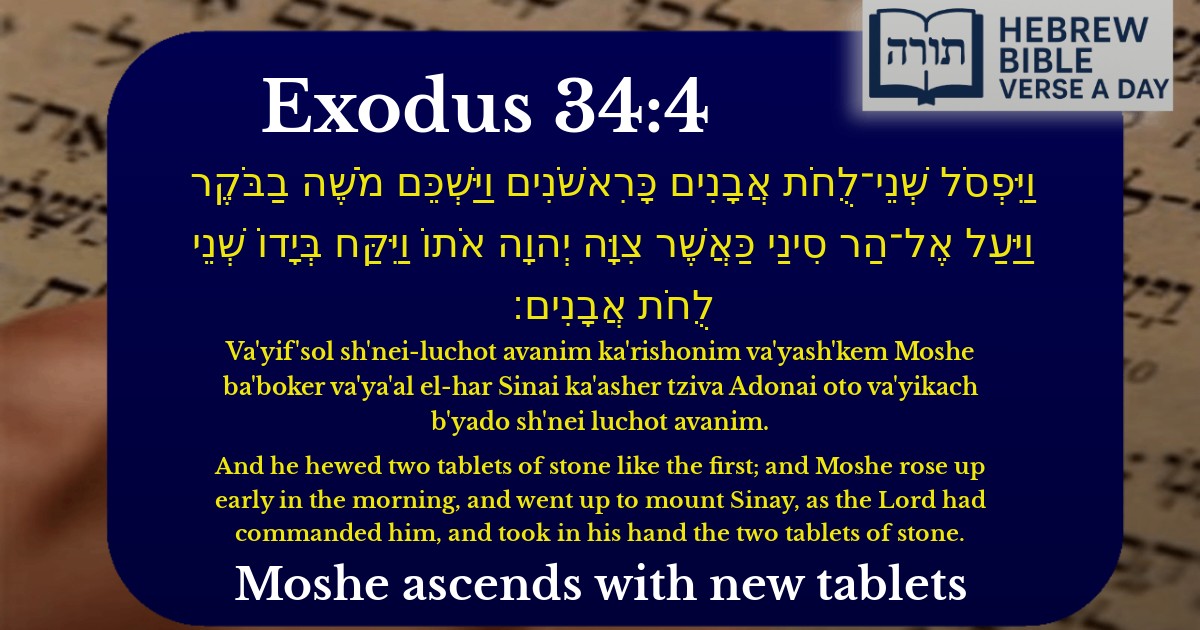Join Our Newsletter To Be Informed When New Videos Are Posted
Join the thousands of fellow Studends who rely on our videos to learn how to read the bible in Hebrew for free!
Hebrew Text
וַיִּפְסֹל שְׁנֵי־לֻחֹת אֲבָנִים כָּרִאשֹׁנִים וַיַּשְׁכֵּם מֹשֶׁה בַבֹּקֶר וַיַּעַל אֶל־הַר סִינַי כַּאֲשֶׁר צִוָּה יְהוָה אֹתוֹ וַיִּקַּח בְּיָדוֹ שְׁנֵי לֻחֹת אֲבָנִים׃
English Translation
And he hewed two tablets of stone like the first; and Moshe rose up early in the morning, and went up to mount Sinay, as the Lord had commanded him, and took in his hand the two tablets of stone.
Transliteration
Va'yif'sol sh'nei-luchot avanim ka'rishonim va'yash'kem Moshe ba'boker va'ya'al el-har Sinai ka'asher tziva Adonai oto va'yikach b'yado sh'nei luchot avanim.
Hebrew Leining Text
וַיִּפְסֹ֡ל שְׁנֵֽי־לֻחֹ֨ת אֲבָנִ֜ים כָּרִאשֹׁנִ֗ים וַיַּשְׁכֵּ֨ם מֹשֶׁ֤ה בַבֹּ֙קֶר֙ וַיַּ֙עַל֙ אֶל־הַ֣ר סִינַ֔י כַּאֲשֶׁ֛ר צִוָּ֥ה יְהֹוָ֖ה אֹת֑וֹ וַיִּקַּ֣ח בְּיָד֔וֹ שְׁנֵ֖י לֻחֹ֥ת אֲבָנִֽים׃
Parasha Commentary
📚 Talmud Citations
This verse is quoted in the Talmud.
📖 Shabbat 86b
The verse is referenced in a discussion about the timing of Moshe's ascent to Mount Sinai and the preparation of the second set of tablets.
📖 Yoma 4b
The verse is cited in the context of discussing the events surrounding the giving of the Torah and the breaking of the first tablets.


Preparation of the Second Tablets
The verse describes Moshe Rabbeinu hewing new tablets of stone after the shattering of the first Luchos due to the sin of the Golden Calf. Rashi (Shemos 34:1) explains that Hashem commanded Moshe to carve the second tablets himself, unlike the first set which were entirely Divine handiwork (Shemos 32:16). This teaches that teshuvah (repentance) requires human effort alongside Divine mercy.
Early Morning Ascent
The Torah emphasizes that Moshe "rose up early in the morning" to ascend Har Sinai. The Midrash (Shemos Rabbah 47:1) notes this demonstrates Moshe's eagerness to fulfill Hashem's command without delay. The Talmud (Berachos 6b) teaches that early morning is an auspicious time for spiritual endeavors, as the soul is refreshed.
Comparison to First Tablets
Symbolism of Stone Tablets
The Kli Yakar (Shemos 34:1) explains that stone represents durability, symbolizing that Torah would now endure despite human failings. The fact Moshe carried them in his hand (unlike the first tablets borne by angels, according to Midrash Tanchuma Ki Sisa 30) shows Torah's accessibility to those who earnestly seek it.
Lessons in Divine Mercy
The Rambam (Hilchos Teshuvah 7:4) derives from this episode that complete repentance can restore one to their previous spiritual level. The replacement tablets demonstrate that after sincere teshuvah, the relationship with Hashem can be fully repaired, though perhaps through a different path.